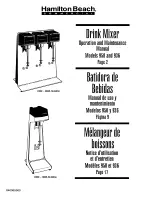
19
Owner’s Manual
Owner’
s Manual
Appendix C: Technical Info
Input Impedance:
Line input:
100 k
Ω
balanced
Phono input:
47.5 k
Ω
shunt with 200 pF
Maximum Output Levels:
Main out:
+15 dBu
Aux out:
+15 dBu
Phones:
1.5 Vrms into 32
Ω
(70 mW)
Output Impedance:
Main out:
120
Ω
Aux out:
120
Ω
Phones:
50
Ω
Equalization
Low:
+10/–inf dB @ 300 Hz
Mid:
+10/–inf dB @ 1 kHz
High:
+10/–inf dB @ 4 kHz
FireWire
Sample rates:
44.1 kHz, 48 kHz,
88.2 kHz, 96 kHz
Resolution: 24-bit
VU Meters
8–segment post main level meters
OL (+13), +10, +7, +4, +0, –4, –10, –20 dBu
Level set LED (sensitivity):
0 dBu
AC Power Requirements:
Power consumption:
8.3 watts
Universal AC power supply:
100–240 VAC, 50–60 Hz
Physical Dimensions and Weight:
Height:
8.6 in/218 mm
Width:
8.8 in/224 mm
Depth:
3.4 in/87 mm
Weight:
2.5 lb/1.13 kg
LOUD Technologies Inc. is always boldly striving to improve
our products by incorporating new and improved materi-
als, components, and manufacturing methods. Therefore, we
reserve the right to change these specifications at any time
without notice.
“Mackie,” and the “Running Man” are registered trademarks of
LOUD Technologies Inc. All other brand names mentioned are
trademarks or registered trademarks of their respective hold-
ers, and are hereby acknowledged.
©2007-2012 LOUD Technologies Inc. All Rights Reserved.
Specifications
Frequency Response (20 Hz to 20 kHz, unity gain) :
Line input to any output:
+0/–0.5 dB
Phono input to any output:
±0.5 dB of RIAA EQ
curve
FireWire output to FireWire input
(with loop out switch engaged):
+0/–0.5 dB
Distortion (THD+N):
Main and aux output, 20 Hz to 20 kHz, 1 kHz input signal:
Line input at unity gain, 4 dBu input signal:
Better than 0.008%
Phono input at unity gain, –30 dBu input signal:
Better than 0.030%
FireWire output to FireWire input : Better than 0.005%
Phones output, 20 Hz to 20 kHz, +4 dBu input signal:
Line input at unity gain:
Better than 0.004%
Attenuation/Crosstalk:
Main level at unity gain, 1 kHz input signal placed on any chan-
nel with gain knob at unity and level knob at minimum,
main outs (20 Hz–20 kHz):
Better than –85 dBu
Main level at unity gain, 1 kHz input signal placed on any chan-
nel with gain knob at unity and level knob at minimum, main
outs measured (20 Hz to 20 kHz) with any other channel gain
knob at unity and level knob at unity:
Better than –85 dBu
Noise Characteristics:
Signal to Noise Ratio, 20 Hz to 20 kHz, ref +4 dBu:
Main out at unity, all channel gain knobs at minimum:
Better than –91 dB
Main out at unity, all channel gain knobs at unity (dummy plugs
in channel 4 TRS inputs so phono is disengaged):
Better than –86 dB
Main out at unity, channels 1 – 3 at minimum, channel 4 phono
at unity gain (no TRS plugs in channel 4):
Better than –74 dB
All channel aux knobs at unity and all channel gain knobs at
unity:
Better than –89 dB
Main out at unity, all channel gain knobs at minimum, FireWire
input level at unity:
Better than –87 dB
Maximum Input Levels (rated at 1% THD):
Line inputs, unity gain:
+15 dBu
Phono input:
77 mV rms @ 1kHz
Input/Output Characteristics:
Input gain control range:
Line input gain knob:
–14 to +14 dB
Line input level knob:
Off to +10 dB
Output gain control range:
Main level knob:
Off to +10 dB
Channel aux knob:
Off to +10 dB










































